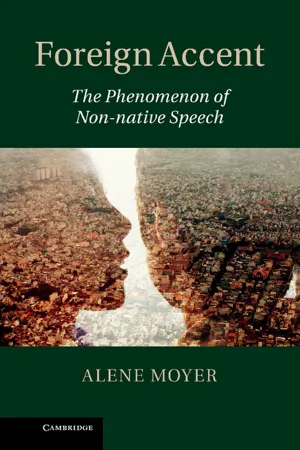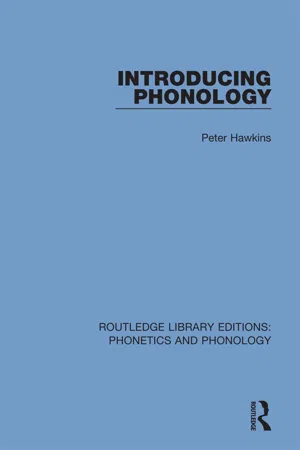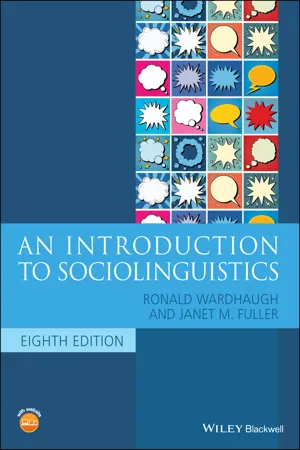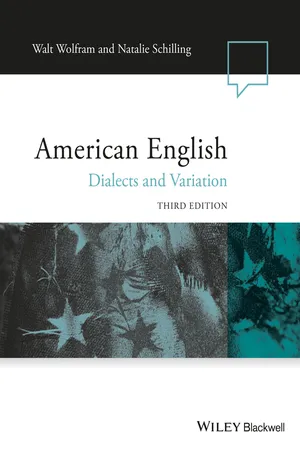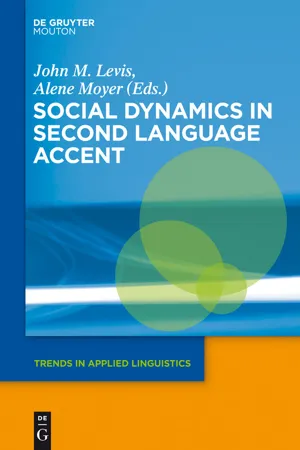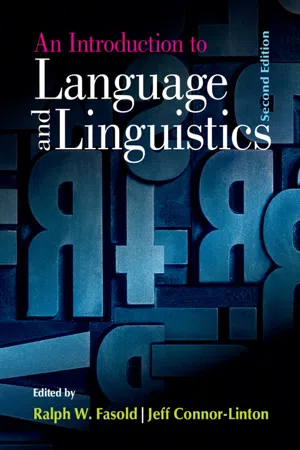Languages & Linguistics
Accent vs Dialect
Accent refers to the way in which words are pronounced, often influenced by regional or cultural factors. Dialect, on the other hand, encompasses not only pronunciation but also vocabulary, grammar, and syntax specific to a particular region or social group. While accent focuses on speech sounds, dialect encompasses broader linguistic features.
Written by Perlego with AI-assistance
Related key terms
1 of 5
12 Key excerpts on "Accent vs Dialect"
- eBook - PDF
Foreign Accent
The Phenomenon of Non-native Speech
- Alene Moyer(Author)
- 2013(Publication Date)
- Cambridge University Press(Publisher)
When speaking with others, we continually adjust our pronunciation and alter our prosody to clarify meaning, punctuate important points, and signal distance vs. affiliation. In other words, we use accent to position ourselves vis-à-vis others. Thus, accent is a fluid, contextualized expression of our personal and social identity as well as our communicative stance. Considering all of the information it conveys, and the deeper significance it carries – social, communicative, linguistic, and psychological – can accent be neatly defined? Let us first consider what accent is not. Accent is distinct from dialect, though the terms are sometimes used inter- changeably. For example, Cockney is both a dialect and an accent, but strictly speaking, dialect refers to a fully functioning language variety with its own vocabulary and grammar, as well as discursive style, in addition to a distinct accent. African American English, Southern Dialect, New England Dialect, etc. are all considered dialects of American English although each varies locally and socially. Thus, in common parlance, both dialect and accent refer to patterned language behavior within distinct regions, social classes, ethnic groups, even age groups, but accent refers only to speech sounds – the phonetics and phonology 1 of a given language variety. Adding to the potential confusion, accent is also used interchangeably with pronunciation, but this is not a precise match either. Pronunciation typically refers to articulation; the place and position of speech organs (tongue, lips, teeth, uvula, larynx, nasal cavity, etc.) when producing specific speech sounds. Accent is a broader term that refers not only to the articulation of individual sounds, or segments, but to suprasegmental features as well: intonation, rhythm, pitch, segmental length, tempo, and loudness. - eBook - ePub
- Peter Hawkins(Author)
- 2018(Publication Date)
- Routledge(Publisher)
8 Dialect, accent In this and the following two chapters we shall be considering some of the major areas which provide data for the study of phonology: variation (i.e. dialects and style); historical change; and language acquisition. This chapter is concerned with dialects – varieties of speech within a single language; and to some extent with style : varieties of speech within a single speaker. In the main part of the chapter, we shall discuss methods for comparing differences of pronunciation. Social dialects The OED defines dialect as ‘one of the subordinate forms or varieties of a language arising from local peculiarities of vocabulary, pronunciation and idiom’.Traditionally, dialects were considered to be mainly regional, as implied by the term ‘local’ in this definition. More recently, however, it has been recognized that social variation, i.e. differences between speakers which can be attributed to factors such as social status and education, is as extensive as, and perhaps even more significant for its speakers than, any purely regional variation. The differences are greatest in those societies with the greatest social stratification, particularly in highly-urbanized communities in which education, technology and literacy rank high in importance. In these societies, one variety usually establishes itself as the standard (see below, p. 227) – and this is often based on the speech of the most educated, or otherwise most prestigious, group within the community. The other varieties then enjoy greater or lesser prestige, depending on a number of factors. Wilkinson (1977:51), for example, distinguishes for British English what he calls ‘first-class’ accents (RP, and certain Scottish and Irish pronunciations), ‘second-class’ accents (the British regional accents) and ‘third-class’ accents (those of the large industrial cities, such as Leeds and Birmingham) - eBook - PDF
Accent and Teacher Identity in Britain
Linguistic Favouritism and Imposed Identities
- Alex Baratta(Author)
- 2018(Publication Date)
- Bloomsbury Academic(Publisher)
If dialect speakers do not come into everyday contact with the standard form, they may not see a reason to change their language use. As has been made clear, however, while there are indeed contexts in which dialectal usage would be seen as highly appropriate (e.g. a local wedding with close family and friends), there are contexts in which its use would not be appropriate. Second, and an important point to make regarding the need to clarify ‘accent’ and ‘dialect’, is that while accent, strictly speaking, refers to one’s pronuncia-tion, and dialect refers to specific use of grammar and lexis, I agree, in conjunc-tion with Crystal (1996), that the two can be intertwined. For example, would speaking in, say, Geordie dialect (referring to the variety found in Newcastle, England) still be seen as authentic if the speaker did not have an accompanying Geordie accent? If we consider the phrase (in Geordie dialect) I’m gannin’ doon the toon (I’m going downtown/to the city centre) delivered in any accent but the one tied to Newcastle, it is very likely that the local people would not see this as authentic, or perhaps see it as somehow ‘incomplete’; if spoken in RP, it might even be perceived as insulting. Or, it could of course be an example of retaining one’s natural accent to otherwise speak in a ‘foreign’ dialect as a means to gen-erate humour. However, Crystal’s (1996) claim that speakers of regional dialects use regional accents simultaneously suggests that we might consider regional pronunciation to be a part of the regional use of grammar and vocabulary also. Accents in Britain and Linguistic Prejudice 59 Thus, while the focus within my book is solely tied to accent (i.e. pronunciation), I nonetheless suggest that for regional dialects to be considered ‘complete’, we need to incorporate the accompanying regional accent as well as regional gram-matical forms and lexis. - eBook - PDF
Pronunciation is in the Brain, not in the Mouth
A Cognitive Approach to Teaching it
- Edward Y. Odisho(Author)
- 2014(Publication Date)
- Gorgias Press(Publisher)
59 C HAPTER 4: L INGUISTIC A CCENT : D EFINITION , C LASSIFICATION AND D EMONSTRATION 4.1. I NTRODUCTORY R EMARKS As mentioned earlier on with regard to the difference between dialect and accent, the former is usually used to refer to a com-bination of grammatical, lexical and pronunciation differences, whereas the latter is essentially confined to pronunciation dif-ferences. In fact, in ESL classroom situations or real-life interac-tions, one is able to identify the accent of an L2 speaker not necessarily based exclusively on pronunciation inaccuracies and deviations from acceptable targeted standard pronunciation. In many instances, there are grammatical, morphological and lexi-cal hints that trigger an accent in pronunciation. Take, for in-stance, the case of some English past tense and past participle formations of verbs which end with suffixes that are in the form of voiced or voiceless consonant clusters. Often such clusters are broken up or reduced in one way or another by Hispanic learn-ers of English because they are alien to their native phonology. For example, the past tense of is and are pronounced as ]. Traditionally, Hispanics try to overcome the problem in one of two ways both of which are, unfortunately, wrong: 1) Reduce the cluster by dropping one of its elements, usually the latter. This means that instead of pro-nouncing [ ] and [ ] correctly, they would simply reduce them to [ ] and [ ]. 2) Insert a vowel between the two el-ements of the cluster, break up the cluster and cause a reshuffle in the syllabic structure of the word. To demonstrate, instead of pronouncing the word or as [ ] and [ ], they are rendered roughly as [ ] and [ ]. Un-doubtedly, this is a grammatical problem but its roots are in pronunciation. In the totality of the performance of English, - eBook - PDF
- Ronald Wardhaugh, Janet M. Fuller(Authors)
- 2021(Publication Date)
- Wiley-Blackwell(Publisher)
Sometimes maps are drawn to show actual boundaries around such variables, bounda- ries called isoglosses, so as to distinguish an area in which a certain feature is found from areas in which it is absent. When several such isoglosses coincide, the result is sometimes Languages, Dialects, and Varieties 35 called a dialect boundary. Then we may be tempted to say that speakers on one side of that boundary speak one dialect and speakers on the other side speak a different dialect. We will return to this topic in chapter 5. However, complicating this picture of dialect regions is the idea of the dialect contin- uum, in which there is gradual change of the language (Heeringa and Nerbonne 2001); we discussed this above with the example of German and Dutch in the northern regions of those countries. Over large distances the dialects at each end of the continuum may well be mutually unintelligible, although speakers can easily understand people in neighboring areas; but the borders between dialect areas are not clear-cut lines as implied by the con- cept of the dialect boundary. Everyone has an accent The term dialect, particularly when it is used in reference to regional variation, should not be confused with the term accent. Standard English, for example, is spoken in a variety of accents, often with clear regional and social associations: there are accents associated with North America, Singapore, India, Liverpool (Scouse), Tyneside (Geordie), Boston, New York, and so on. However, many people who live in such places show a remarkable uni- formity to one another in their grammar and vocabulary because they speak Standard English and the differences are merely those of accent, that is, how they pronounce what they say. - eBook - ePub
American English
Dialects and Variation
- Walt Wolfram, Natalie Schilling(Authors)
- 2015(Publication Date)
- Wiley-Blackwell(Publisher)
When we live a certain way, we are expected to match that lifestyle with our talk. And when we don’t match people’s expectations of how we should talk, the incongruity between words and behavior also becomes a topic for conversation. Language differences are unavoidable in a society composed of a variety of social groups. They are a “fact of life.” And, like other facts of life in our society, they have been passed down with a peculiar mixture of fact and fantasy. 1.1 Defining Dialect Given the widespread awareness of language differences in our society, just about everyone has some understanding of the term DIALECT. However, the technical use of the term in linguistics is different from its popular definition in some important but subtle ways. Professional students of language typically use the term “dialect” as a neutral label to refer to any variety of a language that is shared by a group of speakers. Languages are invariably manifested through their dialects, and to speak a language is to speak some dialect of that language. In this technical usage, there are no particular social or evaluative connotations to the term – that is, there are no inherently “good” or “bad” dialects; dialect is simply how we refer to any language variety that typifies a group of speakers within a language. The particular social factors that correlate with dialect diversity may range from geographic location to complex notions of cultural identity. Furthermore, it is important to understand that socially favored, or “standard,” varieties constitute dialects every bit as much as those varieties spoken by socially disfavored groups whose language differences are socially stigmatized - eBook - ePub
- John M. Levis, Alene Moyer, John M. Levis, Alene Moyer(Authors)
- 2014(Publication Date)
- De Gruyter Mouton(Publisher)
The accent as skill perspective emphasizes the ability to form new perceptual categories. This ability is thought to be encumbered by maturational changes that are neuro-biological and/or cognitive in nature. By contrast, the accent as identity view seeks to understand the importance of attitudes, motivation, and the extent of one’s desire to sound like a native speaker of the target language. It therefore seeks context-specific explanations for phonological attainment related to the depth and breadth of the one’s social networks, one’s attitudes regarding both L1 and L2, and even external (listener) attitudes about L2 speakers and their accents. Both perspectives should be appreciated, because more than any other aspect of language, phonological acquisition draws on both cognitive and affective influences. Accent is both deeply internal – cognitively and psychologically – and inherently social in nature, regardless of the specific learning circumstances. This holds as true for the mother tongue(s) as it does for any subsequently learned languages (Moyer, 2013). dp n="18" folio="12" ? Pronunciation 2 in another language is not simply a matter of making oneself understood on an acoustic level. Pronunciation conveys linguistic meaning at the same time that it indicates social identity and communicative stance. This is because the way we sound overall, our accent, is in many ways an expression of who we are, where we come from, and who we would like to be. L2 phonology 3 is an area that therefore merits investigation on many levels. The segmental level is obvious in constructs like degree of accent, while a broader understanding of communicative, discursive fluency is front and center when we speak of suprasegmental skills - eBook - ePub
- Martin Montgomery(Author)
- 2008(Publication Date)
- Routledge(Publisher)
What we have been considering, in effect, is the accent aspect of dialect differences, where ‘accent’ as a term is exclusively reserved for whole patterns of pronunciation typical of a particular region or social group. The term ‘dialect’ covers a broader range of differences, including not only matters of pronunciation, but also distinctions in vocabulary and sentence structure. The extension of a language (say, English) through space and through time allows for quite fundamental differences to emerge and exist side by side within the whole, as its speaker’s move and settle, shape it to express new experiences, and it comes into contact with other languages. It will be changing continuously, but at differing rates within the sub-communities of the English speech community. Some of these changes will be instigated locally but many of them will spread out in waves from centres of power and influence, moving probably from city to city first, and then only later and more slowly encompassing the intervening rural areas. It is the varying and uneven rates of change actually ‘on the ground’, so to speak, that make dialect differences inevitable. None the less, if the hold of the centre on the periphery is strong (through, for example, uniform legal, administrative, educational and writing systems) then, despite the fact of language change, there will be strong pressures in the direction of linguistic conformity. Thus, within the British Isles many of the more fundamental differences of vocabulary and sentence structure between the English dialects have become eroded (not to mention, of course, the drastic decline – sometimes active suppression – of Welsh and Gaelic). Often, all that remains as a kind of historical residue of the original dialect is its distinctive mode of pronunciation – its accent. For this reason, we now have a situation in which the standard dialect is spoken with many differing regional accents.Factors Underlying the Survival of AccentsHow is it that English accents have survived the merging of dialects? One important factor is probably mutual intelligibility. Groups who use different dialects but have some degree of contact with each other will find ways of erasing the linguistic obstacles to mutual understanding, if they want to communicate with each other and if they have need to do so. In this respect, accents are much less of an obstacle to mutual understanding than basic differences in vocabulary and sentence structure. A further factor that underpins the continuing vitality of accents is mentioned in the previous discussion of split reactions to prestige forms. Basically, a large proportion of the working class, while recognizing the prestige value of certain forms, none the less identifies strongly with the speech patterns of its own locality. In terms of accent this leads to a coneor pyramid-like distribution of various forms, a situation that for the British Isles can be summed up in the following way. - eBook - PDF
- William Bright(Author)
- 2019(Publication Date)
- De Gruyter Mouton(Publisher)
DIALECT STUDIES, REGIONAL AND SOCIAL FREDERIC G. CASSIDY PRELIMINARY The field of dialectology, in the United States or anywhere else, is a peculiar one at best. The fact that a dialect does not differ in kind from a language, that languages can sometimes be seen as dialects, makes definition difficult and even arbitrary. 1 A dialect is always a subtype, but how different it may or must be from other subtypes (except idiolects), or in what respects, has no established limits. To recognize the existence of a dialect, its differences must be emphasized; hence a dialect is seldom seen in and as itself. Strictly speaking, no dialect can be fully described unless its fellow dialects are described too, setting out their common elements and those in which they differ. In practice this has seldom been done; usually (and for good practical reasons) the variant forms are thrown into contrast with the 'standard' or officially accepted dialect. This emphasis on variance from the 'right' form of the language is responsible for making dialect seem queer or quaint to the public and for leading even some scholars to treat it unsystematically. Before the rise of scientific language study, interest in dialect was chiefly anti-quarian. But the attempt in the late eighteenth and early nineteenth centuries to recover lost stages of languages and to work out their interrelationships brought wider scholarly attention to dialects at last. Though the fact is now nearly forgotten, the proposal and elaboration of the Indo-European hypothesis was one of the most exciting intellectual developments of the century. Not surprisingly, language models of the time were Darwinian: languages are the genera, dialects the species; languages form trees of descent, like living creatures, and so on. Dialects were thought of as individually distinct units, anchored areally and limited to the lower strata of society. - eBook - ePub
- W.R. O'Donnell, LORETO Todd(Authors)
- 2013(Publication Date)
- Routledge(Publisher)
By the time emigration from Britain began on a substantial scale in the seventeenth century, Standard English was firmly established as the vehicle for a rich and extensive literature. Above all, it was the language of the Bible. For the emigrants, accordingly, Standard English was the form of English through which they had access to their cultural and religious roots. So it continued to enjoy the high prestige it had in Britain, and with the same effect that it encouraged the adaptation of the grammar and vocabulary of writing to the spoken language, through the agency of schools and literature. Far from the dialect English in the various overseas territories separating from one another and from the dialect English of the mother country, they have remained part of one large continuum, all of them related to a standard language which is identical with none of them. Pidgins and creoles are a different matter, and these will be discussed in the next chapter.The reality of regional dialect English, then, is continuous change, from place to place, even from person to person. In some places, particularly where some geographical feature has caused actual physical separation, differences become more numerous than elsewhere, but nowhere is the essential continuity of the language seriously interrupted, so that the boundary drawn round a regional dialect is an artificial one, in the sense that there will be both differences contained within it and similarities shared across it. This dialect continuum is manifest only in speech.Alongside it exists the standard language, originally a local variety but now independent of any particular region. This standard, even today, is the mother tongue of only a minority of English speakers. The rest have to acquire it through the written medium and the school. Once acquired, however, it is available for both speech and writing; though we must emphasise once again that it has no standard pronunciation.Complex as this picture may appear, it is only a partial account of dialect variation since it does not include the very important factor of social class which we have still to consider and which introduces a third dimension into the two-dimensional picture of variation we have been considering so far. At any given locality on the regional dialect continuum, we should expect to find class differences between people which manifest themselves in the way they speak.Class, in the present context, is a socio-economic variable which relates to such more or less objectively identifiable indices as occupation, income and type of housing. In its influence on language, however, it may in addition involve such seemingly linguistically irrelevant considerations as religion and race. In Northern Ireland, for example, an individual’s place on the class scale is at least partly determined by whether he is Catholic or Protestant, with the former being generally regarded as socially inferior to the latter; other things being equal. The class differences thus established correspond to dialect differences to such an extent that, especially at the lower end of the social scale, members of the two communities are able to recognise their co-religionists purely by their language. Thus, working-class Catholics and Protestants alike would recognise, for instance, ‘backy’, ‘bardicks’, ‘bracky’, ‘brosny’, ‘drachy’, and even ‘Catholic’ itself as being Catholic terms, the Protestant equivalents being ‘lame’, (small) ‘possessions’, ‘speckled’ (of a hen), ‘small sticks’, ‘tedious’ and ‘Tague’ respectively. The social effect of race can be even more distinctive; in the United States, for example, where in many cities black people constitute a separate social class whose language qualifies for the distinctive name of ‘Black English’. - eBook - PDF
- Ralph W. Fasold, Jeff Connor-Linton(Authors)
- 2014(Publication Date)
- Cambridge University Press(Publisher)
In addition, slang words typically carry some sort of non-neutral social meaning and usually have non-slang synonyms that are more neutral in tone. (Compare, for example, wack vs. strange or kick the bucket vs. die .) Further, slang words are usually considered to be short-lived, though, in reality, some “ slang ” terms have been around for generations. (For example, the terms 322 Natalie Schilling dough for ‘ money ’ and fl unk for ‘ fail ’ have been around since at least the early twentieth century.) Jargon also pertains to the lexical level of language and refers to terms associated with a particular sphere of activity – for example, computer jargon or legal jargon. A further point is that dialect is not the same thing as accent, since accent refers only to the phonological level of language, and dialects, again, are characterized by features on all linguistic levels. A fi nal issue that arises as we think about “ language, ” “ dialect, ” and related terms is how to determine whether a particular language variety should be classi fi ed as a dialect of another, larger language or whether it should “ count ” as a language in its own right. At fi rst glance, it might seem that we could apply some relatively straightforward criteria: if two varieties are very similar linguistically and are mutually intelligible (that is, if the speakers of one variety can understand the speakers of the other and vice versa), then it seems that they should count as dialects of a single language. Conversely, varieties that are linguistically quite distinct and are not mutually intelligible should probably be classi fi ed as separate languages. In reality though, labeling varieties as “ languages ” or “ dialects ” is usually a bit more complicated, and what “ counts ” as a dialect vs. a language has as much – probably more – to do with cultural and political issues than with linguistic ones. - eBook - PDF
Linguistics for Everyone
An Introduction
- Kristin Denham, Anne Lobeck(Authors)
- 2012(Publication Date)
- Cengage Learning EMEA(Publisher)
But when we discriminate against someone based on the way he or she talks, we discriminate against that person. We make all kinds of assumptions about each other based on the way we dress, the kind of car we drive, where we live, and how we talk. The way we talk, our dialect, is intertwined with our identity. It remains somewhat accept-able in our society to criticize people’s speech—their accents, their vocabulary choice, their syntax. We can find numerous examples of people making judg-ments about others’ speech: “[He spoke with a] working-class accent thicker than the sludge at the bottom of a can of baked beans” (Newman 2004). This discrimination is most obvious with two of the most stigmatized American dialects: Southern dialects and African American dialects (there are several subtypes of each variety). Consider the assumptions underlying this sentence from a newspaper. “For 37 years, Charles Kuralt has shown us what network news can be—calm, thoughtful, perceptive. Beneath that deceptive North Car-olina drawl, there’s a crisp intelligence” ( Daily Guide 1994). The assumption is that a Southern dialect indicates that someone is likely a bit slow, not very smart; thus, it is surprising if they are smart. Edward Ayers (1996) tells of a Virginian who attended Harvard in the early 1980s and wished he could just put a sign around his neck to stave off the ques-tions that came up, or that he thought people were at least wonder-ing about, when they heard him speak: “Yes, I am from the South. No, I do not know your uncle in Mobile . . . Both of my parents are, in fact, literate . . . No, I do not own slaves. No, I do not want any.” The stereotype of Southerners as uneducated, gullible slave owners continues to play out in the media, in books, and in schools. It re-mains quite prevalent even when recognized as unfair and untrue. Stephen Colbert, host of the popular “news” show The Colbert Report , changed his Southern accent (he’s from Charleston, South Carolina).
Index pages curate the most relevant extracts from our library of academic textbooks. They’ve been created using an in-house natural language model (NLM), each adding context and meaning to key research topics.
